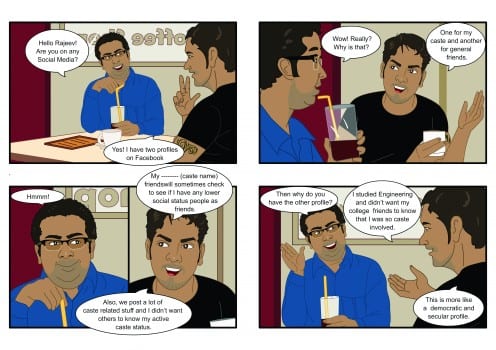Who Am I? – The Case of Caste Related Profiles on Facebook
By Shriram Venkatraman, on 11 April 2014
 The above cartoon says it all. There are quite a few cases here in my field site as well as in the villages closer to it where this sort of double existence on Social Networking Sites (SNS) seems natural and required. The thinking being that this was the right thing to do in order to avert caste problems or issues of any sort. While this sounds like a great strategy to follow, when seen superficially, this actually indicates identity confusion. This seems specific to the rapidly transforming (urbanizing), rural areas especially closer to bigger cities. Given that my field site is one such peri urban area, I encountered such an identity crisis in my informants quite often.
The above cartoon says it all. There are quite a few cases here in my field site as well as in the villages closer to it where this sort of double existence on Social Networking Sites (SNS) seems natural and required. The thinking being that this was the right thing to do in order to avert caste problems or issues of any sort. While this sounds like a great strategy to follow, when seen superficially, this actually indicates identity confusion. This seems specific to the rapidly transforming (urbanizing), rural areas especially closer to bigger cities. Given that my field site is one such peri urban area, I encountered such an identity crisis in my informants quite often.
This identity crisis of a person of a rural background (specifically young men/women) suddenly finding himself/herself in the midst of a rapid urbanization, manifests itself on social networking sites, where you have one caste based SNS profile and another more secular one. The idea is to not really mix these two as you tend to now live both the lives at the same time. However, my informants feel that it sometimes becomes confusing on who they really are and what ideology they really subscribe to. So when I asked Rajeev (the person in the cartoon), which profile would thrive for a longer time and which profile is a true reflection of himself; he said he really didn’t know. But, he was quick to add that it might be the one which is secular, since he thought that he might move away from the village looking out for a job sometime soon and secular was the way to go. However, once again, he reverted to saying that he might still have both the profiles separate without anyone (except for a handful of friends) from either of these profiles knowing that the other one exists, since he didn’t want anyone from his village to be offended. I asked him if he liked his caste based kin and his activity on the caste based profile; he replied that he loved it, as it was what had made him what he is today. But, he thought the secular profile from his college days was also important since it was the one which gave him his friends’ network, a great worldview and a politically correct picture of him.
After multiple interviews with such informants, it became rather clear that they were in a way struggling to understand and see who they really were and what was the image they were trying to project to the world. It was like they were being pulled on both sides by two opposite ideological forces at the same time. Escaping the geographical boundaries of the village seemed to be a solution to end both the social control and enabling the merging of identities. However, the emotional attachment to one’s caste and kin made them to hesitate to leave the caste based boundaries. Maybe, their identity itself was about existing in both the worlds at the same time and this is what is very clearly reflected on their SNS profiles.
 Close
Close




